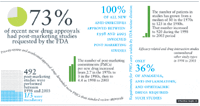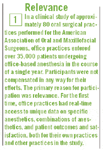Forget Selecting a Site — Now the Site Selects You
Pharmaceutical Executive
Post-approval studies, at many companies, do not have a consistent strategy that builds networks of investigators.
Pharma companies looking to put together post-approval studies in the near future may be in for a big surprise: Competition for sites is heating up. Not only do post-approval studies represent the fastest growing area of clinical research spending—currently hovering around 23 percent, according to Thomson CenterWatch, the Boston-based information services company—but the number of FDA requested post-marketing studies has shot up from 30 percent in the late 1990s to 75 percent last year, according to the Tufts Center for the Study of Drug Development.
Clearly, as post-approval studies are increasingly designed to meet a myriad of scientific, regulatory, and commercial objectives, they will need to target larger numbers of sites—and larger numbers of patients. As a result, competition to enroll a site in a post-approval study will rise dramatically and companies looking to get into the fray will need to be ready.

Critical to convincing sites to participate in post-approval studies is recognizing how post-approval studies differ from pre-approval trials, and why sites elect to participate in these programs. Not only are the types of sites and the goals of the research different, but the reasons that motivate sites to participate can also vary between the pre- and post-approval study groups. However, winning site participation ultimately rests in creating compelling post-approval programs that have real-world impact, answer important questions, cause minimal practice disruption, and provide enough value to participants to justify their time and effort.
Say No to the Status Quo
While some post-approval studies possess inherent positive-characteristics for driving site participation, few company sponsors have an overall strategy or consistent approach for convincing sites to sign up. Part of the problem is that post-approval studies do not even have a consistent home within many sponsor companies, let alone a consistent strategy that will progressively build networks of post-approval investigators. On one hand, you have sponsors that clearly distinguish the strategy, planning, and management of post-approval studies through different teams, technologies, and processes. Others manage post-approval studies through their clinical development organizations. While the former approach may be more likely to hone programs to the unique needs of post-approval sites, the latter offers cost efficiencies in leveraging—not duplicating—internal resources. Obviously, both approaches have their advantages. Regardless of where post-approval studies sit in the operational hierarchy, a clear understanding of the unique requirements of post-approval studies is the key ingredient, whether a study is launched to monitor safety or to demonstrate product value.
Fortunately, there is an opportunity for sponsors to outperform the competition in post-approval study participation. Leveraging this opportunity starts with understanding some of the unique aspects of the post-approval world, and the need for post-approval research programs to attract the attention of real-world clinicians.
Competition for Sites
Post-approval studies compete for the participation of sites. Almost by definition, post-approval sites are real-world physician offices or hospitals focused on patient care, and therefore, not focused on clinical research. Most physicians have limited capacity to add any additional work without trade-offs in their practices. And, most hospitals are economically constrained and leery of diverting resources away from core objectives. Those that elect to participate can rarely scale up to participate in more than a few simultaneous studies—and if they did, they might be less representative of the real-world clinical practice that most post-approval studies are trying to sample. As a result, post-approval sites tend to participate in far fewer studies than pre-approval research sites do.
Adding to the competition for sites is the fact that post-approval studies tend to be larger than pre-approval studies for two reasons: They are designed to detect differences in larger, more diverse patient populations than were available for the pre-approval studies, and post-approval studies that are aimed at clinical relevance and contain large patient numbers are often compelling to physicians reading publications. With larger studies by more companies in the same disease areas—diabetes, coronary artery disease, and oncology, for example—competition for sites increases. And, while site payments should be at the appropriate market level for the work involved, the ability to recruit sites cannot be overcome with increased payments.
With the need to avoid even the suggestion of inducement in studies on marketed drugs, economic incentives for post-approval studies are significantly constrained. Therefore, convincing sites to participate in post-approval studies centers on understanding what motivates a practice or hospital to participate in a study, as well as the barriers to participation, and then identifying how to optimize study design and execution around both.
To Enroll or Not to Enroll
The primary motivating factors for post-approval investigators are based on the direct relevance of the study to the office practice or hospital. The largest barrier is the fear of practice disruption and potential loss of productivity. The most successful post-approval studies offer additional secondary gain to further offset that barrier. The secondary gain is not economic, but rather, derived from such things as the pride of participation in a large and recognized study.
"Real-world doctors are busy and a Phase IV research study needs to grab their attention," says Tom Marshall, executive director of the American Association of Neurological Surgeons. "The way to do that is through relevance and value," he says. Delivering additional value to the sites is a strategic differentiator in recruiting for post-approval studies and to building networks of investigators for comprehensive post-approval programs. A goal of a post-approval study, through design, execution, and technology, should be to delight the sites.
Real-World Relevance
Most physicians and hospitals participate in post-approval studies because they are interested in the disease area and they want to learn something from the study. A good post-approval study design is positioned around the relevancy needs of the sites—these concerns should be the focus of the initial design phase. Not only should the design team include research advisors, but representatives of the targeted clinical practice settings also need to take part.
To be relevant to a busy practitioner, the data should also be useful. In an article entitled "Practical Clinical Trials," which appeared in the Journal of the American Medical Association in 2003, Carolyn Clancy, MD, director of the Agency for Health Research and Quality, and other colleagues called upon both industry and academia to design studies that would have practical relevance to clinical decision making. In addition, physicians and hospitals have other uses for data, ranging from justifying their processes to third party payers to demonstrating quality improvement. Having the ability to download their own portion of the dataset can also be a big differentiator for sites that need their data for negotiations or their own research purposes. [See "Relevance"]

Relevance
Keep it Simple
Convincing a site to participate in a post-approval study means convincing the doctor and the office staff that the program will not impose undue burden, or distract or disrupt the office practice. Case report forms have to be streamlined; every data element should be justified. Technology can greatly assist these tasks, but it has to be user-friendly, highly intuitive, and geared toward research-naï sites that are likely to use the systems on a limited basis.
"Electronic data capture [EDC] allows geographically diverse sites to manage their own data, which works well in the less-monitored registry setting," says Karen Stein, MD, MPH, director, medical affairs, Sanofi-Aventis. "The advantage of EDC over individual site databases is the cleaning, processing, digesting, and synthesis of a central database and the benchmarking standardized and centralized data collection facilitates. One huge advantage of electronic data capture is the mobility of questionnaire design, that is, individual responses can allow tailoring of subsequent questions, resulting in improved sensitivity and specificity and far greater efficiency," she says.
Also helpful is providing workflows that show the site how the study can be incorporated into their practice or hospital without disruption. Usually three or four sample workflows will accommodate the vast majority of practice situations. These workflows can be immensely valuable in convincing a site to participate. Here's a real world example: In a post-approval study of cervical cancer detection, a major medical device company devised a simple one-page data abstraction form to collect key information. A web-based data collection and reporting system, which required less than 10 minutes training at most sites, was utilized. Critically, the system was demonstrated to the sites as part of the recruitment effort so administrators could see for themselves how easy it really was to participate. In a little over three weeks, more than 650 administrators were identified, enrolled, fully trained, and had entered their first patient.
Custom Value
When it comes to the benefits that can be derived from participating in a particular study, the sky's the limit. The key is zeroing in on the needs of the site. For example, orthopedic surgeons have different needs than cardiologists, and hospitals have different value drivers than office practices.
Tactics to implement this strategy range from patient management tools to practice or hospital management tools. For example, providing an automated means to communicate with referring doctors provides the office practice with both better patient care and a practice-building opportunity. Providing benchmarking to hospitals can be used for quality improvement, negotiating with third party payors, or to meet an accreditation requirement. [See "Killer Apps,"]

Killer Apps
Giving Back
One of the reasons investigators participate in post-approval studies is for the sense of giving something back to the medical community. For those for whom research is an avocation, participation in an important study or registry can be a source of pride. The most successful programs are ones that become brands in and of themselves. Genentech's National Registry of Myocardial Infarction or the American Heart Association's Get With the Guidelines are examples of programs that have achieved brand status through numerous abstracts, publications, and citations. It's worth keeping in mind that the reason the Phase IV investigator gives up a weekend to attend a meeting is not for the sun or the golf, but for the intellectual community around an area of interest and the ability to learn more about the study's findings.
[See "Value Add,]

Value Add
Devil in the Details
Ultimately, convincing sites to participate in post-approval studies will depend on a sponsor's track record. With that in mind, don't forget the following:
- Pay the sites accurately and on time. While money is not the primary motivator, payment disputes lead to frustration and anger. Online payment reports for the site and sponsor may be one way to avoid confusion or problems.
- The help desk is the site's primary ambassador; a good relationship will make recruitment for the next study much easier. Make sure your study help desk is knowledgeable, courteous and responsive.
- Remember, it's the site's data. They may want to use it to better or inform their practice, so making it inaccessible without good reason is not well received in post-approval studies. Putting boundaries on specific data elements or releasing information prior to a group publication is expected. However, unlike with pre-approval studies, making data more accessible will become the post-approval norm.
- Implement easy-to-use technology and make sure it is focused on the needs of post-approval studies. It should be flexible (it should allow users to work in a variety of ways, such as Web and voice) and should enable the sponsor to build a community of research-naï investigators across multiple integrated programs. It should also provide tools that enable sites to access and even manipulate localized data. The system will also need to be inter-operable with other practice or hospital information systems to decrease redundant data capture.

Up, Up, and Away
Richard Gliklich, MD is president and CEO of Outcome, a provider of strategies and solutions for registries and post-approval studies. He can be reached at richg@outcome.com

Addressing Disparities in Psoriasis Trials: Takeda's Strategies for Inclusivity in Clinical Research
April 14th 2025LaShell Robinson, Head of Global Feasibility and Trial Equity at Takeda, speaks about the company's strategies to engage patients in underrepresented populations in its phase III psoriasis trials.
Beyond the Prescription: Pharma's Role in Digital Health Conversations
April 1st 2025Join us for an insightful conversation with Jennifer Harakal, Head of Regulatory Affairs at Canopy Life Sciences, as we unpack the evolving intersection of social media and healthcare decisions. Discover how pharmaceutical companies can navigate regulatory challenges while meaningfully engaging with consumers in digital spaces. Jennifer shares expert strategies for responsible marketing, working with influencers, and creating educational content that bridges the gap between patients and healthcare providers. A must-listen for pharma marketers looking to build trust and compliance in today's social media landscape.
Pfizer, GSK Gain ACIP Recommendations for RSV and Meningococcal Vaccines
April 18th 2025The Centers for Disease Control and Prevention’s Advisory Committee on Immunization Practices voted to expand access to Pfizer’s respiratory syncytial virus vaccine Abrysvo for high-risk adults in their 50s and voted in favor of GSK’s meningococcal vaccine, Penmenvy, for streamlined adolescent protection.